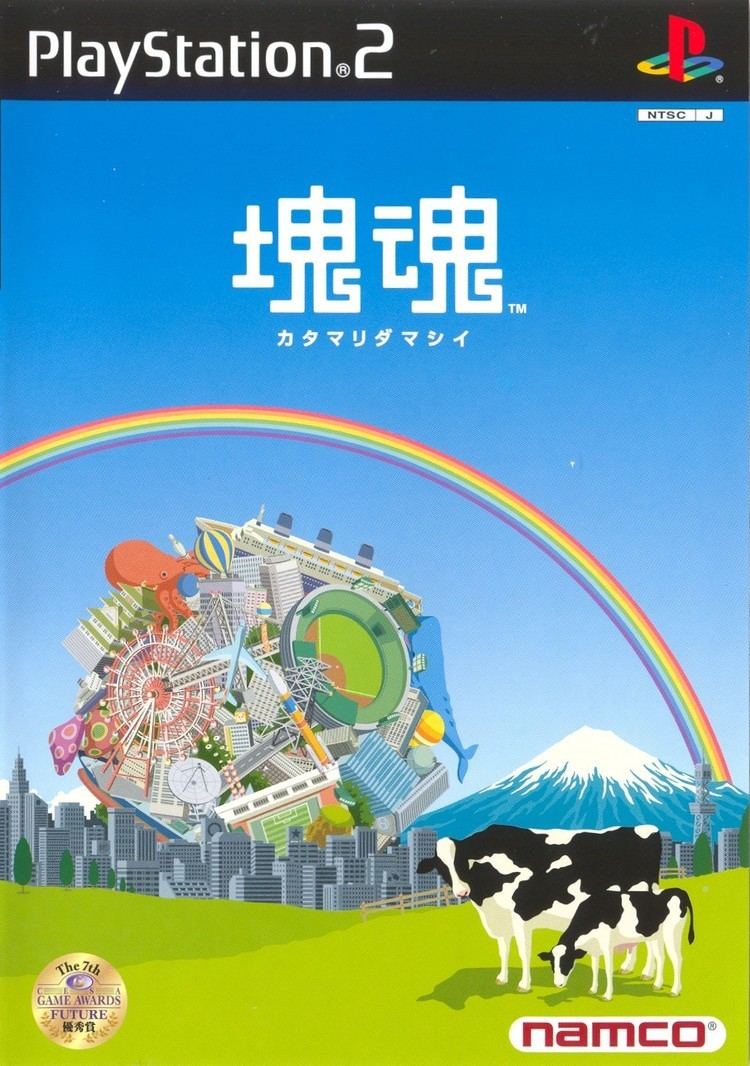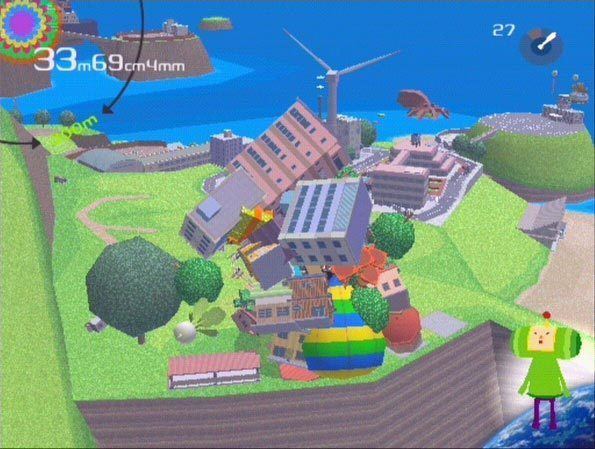Programmer(s) Kazumi Yamabe | Initial release date 18 March 2004 Series Katamari | |
 | ||
Producer(s) Hideki TomidaMitsumasa Fujita Artist(s) Keita TakahashiTakashi YoshidaMoe Miura Composer(s) Yuu MiyakeAsuka SakaiAkitaka TohyamaHideki TobetaYoshihito YanoYuri Misumi Similar Keita Takahashi games, Puzzle video games | ||
Cgrundertow katamari damacy for playstation 2 video game review
Katamari Damacy (塊魂, Katamari Damashii, lit. "clump soul") is a third-person puzzle-action video game developed and published by Namco for the PlayStation 2. It was first released in Japan and then later in North America. The game resulted from a school project from the Namco Digital Hollywood Game Laboratory and was developed for less than $1 million. In designing Katamari Damacy, the development team aimed to maintain three key points: novelty, ease of understanding, and enjoyment.
Contents
- Cgrundertow katamari damacy for playstation 2 video game review
- Katamari damacy ep 12 radical cosmic terrorism supermega
- Synopsis
- Gameplay
- Development
- Reveal and release
- Name
- Soundtrack
- Reception
- In the Museum of Modern Art
- Sequels
- Legacy
- References

The game's plot concerns a diminutive prince on a mission to rebuild the stars, constellations, and Moon, which were accidentally destroyed by his father, the King of All Cosmos. This is achieved by rolling a magical, highly adhesive ball called a katamari around various locations, collecting increasingly larger objects, ranging from thumbtacks to people to mountains until the ball has grown great enough to become a star. Katamari Damacy's story, characters, and settings are bizarre and heavily stylized, rarely attempting any semblance of realism, though the brands and items used are based on those current in Japan during the game's production.

Overall, Katamari Damacy was well received in Japan and North America. The game was dubbed a sleeper hit and won several awards. Katamari Damacy inspired the development of other video games, and led to the release of eight sequels in Japan and other territories: We Love Katamari (PlayStation 2), Me & My Katamari (PlayStation Portable), Beautiful Katamari (Xbox 360), i Love Katamari (iOS, Windows Phone 7, Android), Katamari Forever (PlayStation 3), Katamari Amore (iOS), Touch My Katamari (PlayStation Vita), and Tap My Katamari (iOS, Android).

Katamari damacy ep 12 radical cosmic terrorism supermega
Synopsis

The primary story in Katamari Damacy deals with the aftermath of the planet-sized King of All Cosmos' binge drinking spree that wiped out all the stars and other celestial bodies from the sky. The King (who appears to be chronically dissatisfied with his 5-cm-tall son's small size) charges the Prince to go to Earth with a "katamari"—a magical ball that allows anything smaller than it to stick to it and make it grow—and collect enough material for him to recreate the stars and constellations. The Prince is successful, and the sky is returned to normal.

A side-story follows the Hoshino family as the Prince works at his tasks. The father, an astronaut, is unable to go to the moon after it is wiped out by the King, and the daughter, whose name is Michiru, "senses" the Prince's work—she can feel when each constellation returns to the sky. Ultimately, the family, along with their house and town, are rolled up in the katamari that is used to remake the moon.
Gameplay

The player controls the Prince as he rolls the katamari around houses, gardens, and towns in order to meet certain parameters set by the King of All Cosmos. The player uses the two analog sticks on the DualShock controller in a manner similar to the classic arcade game Battlezone to control the direction the katamari rolls. Other controls can be triggered by the player to gain a quick burst of speed, flip the Prince to the other side of the katamari and more.
Objects that are smaller than the katamari will stick to it when the player comes into contact with them, while greater objects can be hurdles; colliding at high speed with any may cause objects to fall off the katamari, slowing the player's progress. The game uses size, weight, and surface area to determine if an object will stick to the katamari. This allows slender objects, such as pencils, that are longer than the katamari is wide, to be picked up, and these will alter how the katamari rolls until more objects are picked up. Animals such as cats will chase the katamari, knocking things from it, but once the katamari is great enough, it will scare the animals away, and they can be rolled up once they are chased down. As objects stick to the katamari, the katamari will grow, eventually allowing objects that were once hurdles to be picked up, and creating access to areas that were formerly blocked. In this manner, the player might start the game by picking up thumbtacks and ants, and slowly work up to the point where the katamari is picking up buildings, mountains, and clouds.
The typical mission given by the King of All Cosmos is the "Make a Star" mode, where the player needs to grow the katamari to a specific size within a given timeframe. Other missions have more specific collecting rules, such as collecting as many items (swans, crabs, pairs) as possible within a given time, or collecting the largest item possible (such as a cow or bear). The player can attempt a score attack mode for any level, in which they try to make the greatest katamari possible in the time allotted. Certain levels can unlock an "eternal mode" by creating an exceptionally large katamari. In eternal modes, the player can explore the level with no time limit.
Each level features two secret items that can be found. The first item is a royal present that contains an object that the Prince can wear. Most gifts are non-functional, but one includes a camera that can be used to take in-game screenshots. The other secret item is a cousin of the Prince, which, once rolled up in main gameplay, can be used as a character in the various multiplayer modes. However, cousins can only be found and rolled up after the game is beaten. The game also tracks which objects the player has collected at any time, allowing them to review all the various objects within the game.
In the two-player mode, a player can choose to play as either the Prince or one of his numerous Cousins. The screen is split vertically; player one on the left and player two on the right. Players compete simultaneously in a small arena to collect the most objects within three minutes. The playfield is replenished with new objects periodically. Players can ram into each other, knocking items from their opponents' katamaris, and if one player leads by a fair amount, then it is possible to roll up the opponent's katamari.
Development
Toru Iwatani, head of research and development for Namco, stated that the idea for Katamari Damacy resulted from Keita Takahashi's school project from the Namco Digital Hollywood Game Laboratory, a sponsored institute for game development education. Keita Takahashi's final thesis bore out the core gameplay ideas, while a team of ten (including the student) developed the final product. The game was developed for less than US$1 million, a tenth of the cost of Namco blockbuster titles such as Ridge Racer or Soulcalibur. The game took a year and a half to develop, with eight months of prototyping.
Lead developer Keita Takahashi said that the team was aiming for four key points in developing the game: novelty, ease of understanding, enjoyment, and humor. Iwatani compared the game to Namco's Pac-Man, which focused on simplicity and innovation and served as a template for future games from the company. At one point during development, Takahashi "proactively ignored" advice from Namco to increase the complexity of the game.
The core gameplay of Katamari Damacy is the subject of U.S. Patent 7,402,104, "Game performing method, game apparatus, storage medium, data signal and program". The patent, issued in 2009, primarily describes how the game maintains the roughly spherical nature of the katamari when objects are picked up, though extends to concepts such as tracking objects collected based on temperature or weight values, which were modes included with later games of the series.
Reveal and release
Katamari Damacy was first revealed at the 2003 Tokyo Game Show, at which the press dubbed it a "snowball simulator". The image featured on the cover of the pre-release demo showed the large red ball used in "Tamakorogashi", a game played at Japanese school sports meets (undokai) that was an influence for the game. Plans for releasing the game in Western countries were tied to its performance in Japan. Katamari Damacy was first shown in the United States at the Experimental Gameplay Workshop during the March 2004 Game Developers Conference. Due to its popularity at trade shows and a write-in campaign, Namco decided to release the game in the United States.
Name
In Japanese, Katamari (塊) means "clump" or "clod" and Damashii is the rendaku form of tamashii (魂) which means "soul" or "spirit". Therefore, the phrase approximates to "clump soul". The two kanji that form the name look similar (sharing the same right-side element 鬼), in a kind of visual alliteration. The name is officially transliterated as Katamari Damacy in most releases. In an interview with Dengeki Online, producer Keita Takahashi said that when asked about the title, "It just popped into my head suddenly, and this is what it has been from the beginning."
Soundtrack
The music in Katamari Damacy was widely hailed as imaginative and original (winning both IGN's and GameSpot's "Soundtrack of the Year 2004" awards) and was considered one of the game's best features. The soundtrack was released in Japan as Katamari Fortissimo Damacy. Its eclectic composition featured elements of traditional electronic video game music, as well as heavy jazz and samba influences (Shibuya-kei). Most of the tracks were composed by Yuu Miyake, and many feature vocals from popular J-pop singers, such as Yui Asaka from the Sukeban Deka 3 TV series, and anime voice actors, including Nobue Matsubara and Ado Mizumori. One track is sung and written by Charlie Kosei, composer of the Lupin III soundtrack.
Reception
Katamari Damacy enjoyed moderate success in Japan. The game was sold at about two-thirds of the price of a new game at the time. It was the top selling game the week of its release with 32,000 units sold, and sold over 155,000 copies in Japan by the end of 2004. However, Namco originally estimated that over 500,000 units would be sold in Japan.
The game was not released in PAL territories such as Europe and Australia since publishers thought it was too "quirky" for these markets; however, Electronic Arts picked up both sequels, We Love Katamari and Me & My Katamari, for release in Europe.
The North American release of the game was very well received by professional reviewers, was mentioned and praised on TechTV, and was a featured sidebar in the May 23, 2004, edition of Time magazine. Time continued to praise the game in its November 22, 2004 "Best games of the year" special, calling it "the most unusual and original game to hit PlayStation2". Most retailers underestimated the demand for such a quirky game, and only purchased a few copies of this sleeper hit; it rapidly sold out nationwide, with sales surpassing 120,000 units in North America. It also won the U.S. award for "Excellence in Game Design" at the 2005 Game Developers Choice Awards, and G4 awarded Katamari Damacy its "Best Innovation" prize in its G-Phoria of that year. Katamari Damacy was one of the recipients of the 2004 Good Design Award in Japan, the first time a video game has won this award. In 2015, the game placed 13th on USgamer's The 15 Best Games Since 2000 list.
Although the game has rapidly achieved a cult following and has been praised by many reviewers, it also has its share of criticism. A common complaint is that the game is relatively short and repetitive—it can be completed in under ten hours, and the gameplay stays virtually the same all the way through. However, others, such as Electronic Gaming Monthly reviewer Mark McDonald (who gave the game 8.5 out of ten with his EGM staff), argue that the game's limitations are made up for by its strengths: "Sure, you're basically doing the same thing each mission, but Katamari's elegant controls, killer soundtrack, and wicked humor make it perfectly suited for replay." As a well-executed, non-traditional game, Katamari Damacy has been influential in the game development community. Since its release, a number of designers have developed works inspired by Katamari: one example is The Wonderful End of the World.
In the Museum of Modern Art
On July 29th, 2012, the game was included in an exhibit at the New York Museum of Modern Art, entitled "Century of the Child: Growing by Design". Here, the game was used to demonstrate the change in toys and "playthings" over the 20th century, specifically praising the game for its "quirky manipulations of scale" that makes it accessible for all ages. Vice president of marketing for Namco Bandai Games America, Inc. Carlson Choi described the inclusion of Katamari Damacy to the exhibit as "a testament to the creative designs embodied in Namco Bandai’s games ... in addition to being a validation of video games as a modern form of interactive art."
On November 29th the same year, the game was included in the permanent collection of video games of the Museum of Modern Art. Curator Paola Antonelli selected Katamari Damacy among the first fourteen games to be displayed in the museum, which was chosen according to a variety of criteria, including "visual quality, elegance of the code and design of playing behavior."
Sequels
Katamari Damacy has spawned numerous sequels on the PlayStation 2 and newer game consoles. The game's direct sequel on the PlayStation 2, We Love Katamari (みんな大好き塊魂, Minna Daisuki Katamari Damashii, literally Everyone Loves Katamari Damacy), was released internationally in 2005 and 2006. Its story is self-referential, following on the success of the first game, most of the levels are based on requests from newfound fans of the King and the Prince. Though sharing the same mechanics, We Love Katamari introduces new gameplay features, such as co-operative play, and new goals, such as collecting the most valuable objects, that would continue through its sequels. Me & My Katamari (僕の私の塊魂, Boku no Watashi no Katamari Damashii, literally My My Katamari Damacy using the two words in Japanese for "I" which connote a masculine ('boku') or neutral ('watashi') speaker) was released for the PlayStation Portable in 2005 and 2006, featuring levels based on helping the animals of an island devastated by a tsunami.
Beautiful Katamari (Beautiful Katamari Damacy (ビューティフル塊魂, Byūtifuru Katamari Damashii)) was an Xbox 360 title released in 2007 and 2008, following the Royal Family using katamaris to close up a black hole created while the King was playing tennis. The newer console allowed for higher-resolution graphics and support for online network play, leaderboards, and downloadable content. While PlayStation 3 and Wii ports were planned for Beautiful Katamari, these never were released.
Katamari Forever (Katamari Damacy Tribute (塊魂TRIBUTE, Katamari Damashii TRIBUTE)) was released for the PlayStation 3 internationally in 2009. Katamari Forever incorporates a mix of previous levels from the series, framed around the King trying to recover from amnesia, and new levels where the katamari is needed to repair the damage done by a rampaging "RoboKing". It further improved on the graphics capabilities of Beautiful Katamari and introduced new moves for the player.
Korogashi Puzzle Katamari Damacy was released for the Nintendo DSi via DSiWare in 2009. Similar in play to Tetris, the player used the prince to drop a katamari into the playing field to clear the puzzle field. Touch My Katamari (Katamari Damacy No-Vita (塊魂ノビータ, Katamari Damashī Nobīta)) is a regional launch title for the PlayStation Vita portable game system in late 2011 and early 2012. The No-Vita moniker is a play on the Vita console name and the Japanese word nobita, meaning "to lengthen or extend". While the core mechanics are similar to other games in the series, Touch My Katamari allows the player to use the rear touch pad on the Vita to temporarily stretch the katamari into an ovoid shape, allowing it to roll through narrow spaces or collect small objects.
Several mobile versions have also been released. Rolling With Katamari was released in Japan in 2007 for the Mitsubishi P904i series of phones, using their tilt-sensitive technology to let the player control the katamari. It was ported to J2ME for release in other countries. Katamari Damacy Mobile was released in 2009 for several wireless devices and is a 2D side-scrolling version of Katamari Damacy similar to a mini-mode included with Me & My Katamari. I Love Katamari was released in 2008 for the iPhone and iPod Touch, with later patched for the iPad and other iOS devices and for Windows Phone 7. Another iOS game, Katamari Amore, was released in early 2011.
WindySoft, a South Korean developer, announced plans for a Katamari Damacy Online game, which was due to be released in 2007. It was never brought to the US.
Legacy
The character of the Prince became a mascot for Namco alongside Pac-Man and makes an appearance in some other Namco-Bandai games, such as Pac-Man World Rally, Noby Noby Boy, the Taiko no Tatsujin series and Keroro RPG: Kishi to Musha to Densetsu no Kaizoku.
